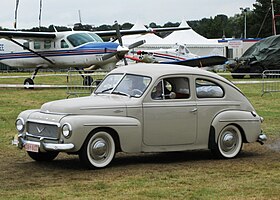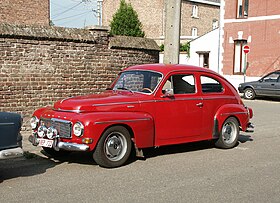Volvo PV544
| Volvo PV444/544 | |
|---|---|
| Overview | |
| Manufacturer | Volvo Personvagnar |
| Production | 1944–1966 |
| Body and chassis | |
| Body style | 2-door fastback |
| Chronology | |
| Successor | Volvo Amazon |
| PV444 | |
|---|---|

Volvo PV444
|
|
| Overview | |
| Production | 1943–1958 |
| Layout | FR layout |
| Powertrain | |
| Engine | |
| Transmission | 3-speed manual |
| PV544 | |
|---|---|
 |
|
| Overview | |
| Production | 1958–1966 |
| Layout | FR layout |
| Powertrain | |
| Engine | |
| Transmission |
|
The Volvo PV is a series of two-door, four-passenger car models — the PV444 and the PV544 — made by Volvo from 1947 to 1966. During World War II's early stages, Volvo decided that a new, smaller car that could deliver good fuel economy would assure the company's future. A raw materials shortage during the war drove home the point that an automobile should be smaller, and also complicated Volvo's ability to mass-produce the product. In 1944, when the car was finally introduced to a car-hungry public, response was very positive and orders poured in from the Swedish population. It was another three years though, until 1947, before series production began.
The PV quickly earned a reputation for being strong and rugged, although the design was considered outdated from early on. The PV also competed successfully, in the American SCCA class but also internationally, with a second-hand PV544 memorably winning the Safari Rally in 1965.
The PV444 was Volvo's first uni-body car. Its body structure was influenced by the 1939 Hanomag 1,3 litre, which was purchased and studied by Volvo engineers. It was also the first Volvo in almost 20 years to come with a 4-cylinder engine. The first PV444s were powered by a 40 PS 1.4 L inline-four engine designated the B4B, with three main bearings, overhead valves, and a single downdraft carburettor. The power of this engine increased to 44 PS (32 kW) in October 1950, and to 51 PS (38 kW) in October 1955. US models, beginning to appear in the US in early 1956, received an uprated version called the B14A which was given twin side-draft 1½ in S.U. carburetors for a total of 70 hp. Most early US sales were limited to Texas and southern California. American customers also had the option of European delivery, in which case they could also get a cheaper model with the basic B4B engine.
By the 1957 model year, engine displacement was increased to 1.6 L and both single downdraft- B16A and twin side-draught carburetted B16B versions were offered. Fuel economy was quite above average for cars sold in the United States. The average American car gas mileage in 1957 according to SAE papers was 12 miles to the gallon. The Volvo PV444 averaged 25 miles to the gallon U.S. and performance particularly with the twin carburetor configuration was brisk. The combination of performance and durability won over many two-seat sports car drivers, allowing them a pleasurable drive in the entire family's company if desired.
...
Wikipedia
